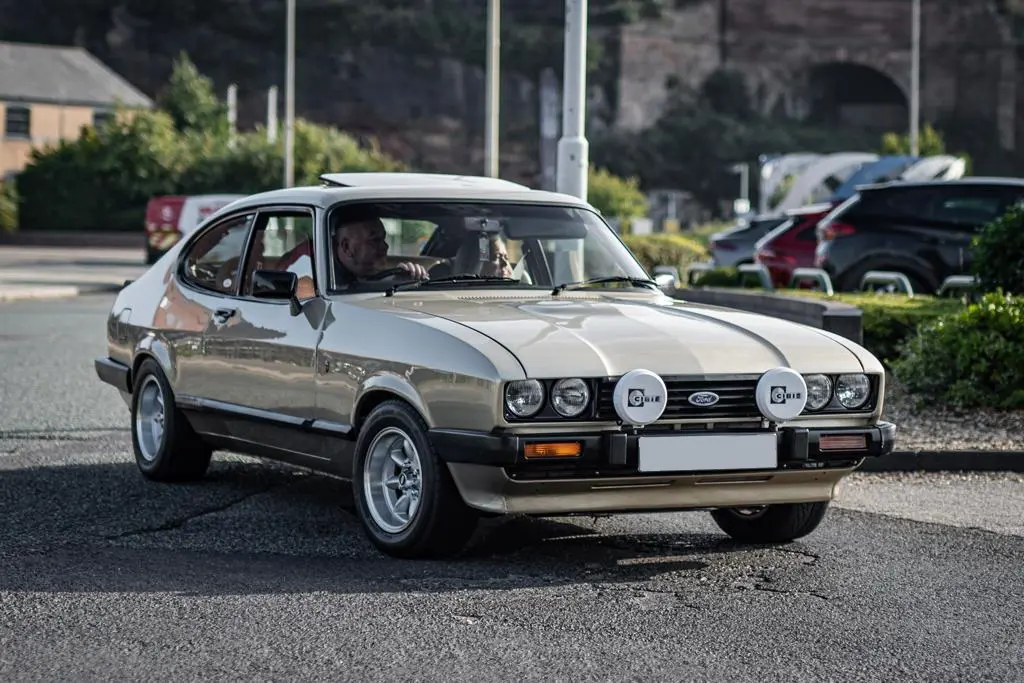MEET THE OWNER – STEVE BRANDRETH AND HIS FORD CAPRI GHIA MK. III
23 February 2023
To say Steve’s Ford Capri Mk. III causes a sensation whenever he goes for a drive would be an understatement. He remarks, “The reaction I get every time I use it is incredible and the number of people that constantly take photos of it at every opportunity beggar’s belief.” His Oyster Gold 3.0 Ghia is one of the earliest third-generation Capris and reflects a longstanding appreciation of Ford GB’s answer to the Mustang. As Steve explains:
“My interest started with Capris when I began my apprenticeship in 1979. A customer at the garage I worked at took an Mk. I ½ 3.0 GXL auto in part exchange. After shunting it around for a few weeks, I was totally smitten with it - but more importantly, the noise it made was EPIC!”

And not only does Steven’s 1978 Mk. III have that same unmistakable Essex V6 note; it is also a form of Capri that the public, and sometimes the classic car press, seem to neglect. To many, the third-generation versions usually mean either the Injection or, thanks to Lewis Collins, the 3.0S in Strato Silver. But the Ghia carved its niche as a grand tourer du jour that was not wildly expensive. Forty-five years ago, anyone who could afford such a magnificent machine probably a) sounded like Patrick Allen and b) wore a medallion over a white roll-neck pullover when off-duty.
The brochure promised a decadent world of automatic transmission, PAS, and even “Verona” cloth upholstery but equipment levels aside; the 3.0 Ghia was almost unique in the British car market. By 1978, when the Mk. III made its bow, Vauxhall offered no direct rival; there was no six-cylinder version of the Cavalier Sports Hatch, while the Royale Coupe was a far more expensive machine. Likewise, Chrysler UK had no competitor for the Capri, while at British Leyland, there was no four-seater MG coupe, and the Triumph Stag ceased production in 1977.
Of course, the prospective buyer might have looked at a Reliant Scimitar GTE, but that also cost far more than the flagship Capri. The Alfa Romeo GTV, a Lancia Beta HPE or a Toyota Celica were alternatives, but none possessed the 3.0 Ghia’s blend of V6 power and sheer presence. The Capri Mk. III was also the sole British-market Ford that could be specified with the 2,994cc engine, the Granada Ghia Mk. II had a 2.8-litre unit, and Dagenham never offered a 3-litre Cortina Mk. IV.
Naturally, Steven had long craved the top-of-the-range Capri Mk. III and he recalls the first time he acquired his Ghia:
“Having loved them for over eight years, it was about time I had to get one for myself. So, I picked up the North West Auto Mart first thing on the Thursday morning and I owned it soon after lunchtime. I sold it three years later, but in 2016, I checked on the DVLA database to see if DLG 444 S still existed and when I noticed it was still about and on a SORN, I asked the question if anyone knew of its whereabouts on quite a few internet forums.”
Mr. Brandreth investigated the location of DLG over the course of that year, and by Christmas 2016, he got a reply from a chap in Ireland telling him he owned it and said, “I suppose you would like to buy it back.” So, a deal was done, and Steven had it trailered back to Widnes in Cheshire.
As for the Ghia’s performance, Steven remarks:
“When I first owned it, the Capri Ghia was an absolute weapon and was absolutely stunning to drive. Fast forward to 2023, and the performance is very ordinary - in fact, my Astra Diesel Van is probably quicker. But the noise it makes still puts a big smile on my face every time I drive it, and I can’t remember ever fuelling it up at a petrol station without having a conversation with someone who had one or knew someone who had an identical one back in the day.”
But then a Capri Ghia Mk. III really does embody “the difference between driving and just motoring” - Capri Mk3 cinema ad - 1979 - YouTube
With Thanks To: Steve Brandreth
